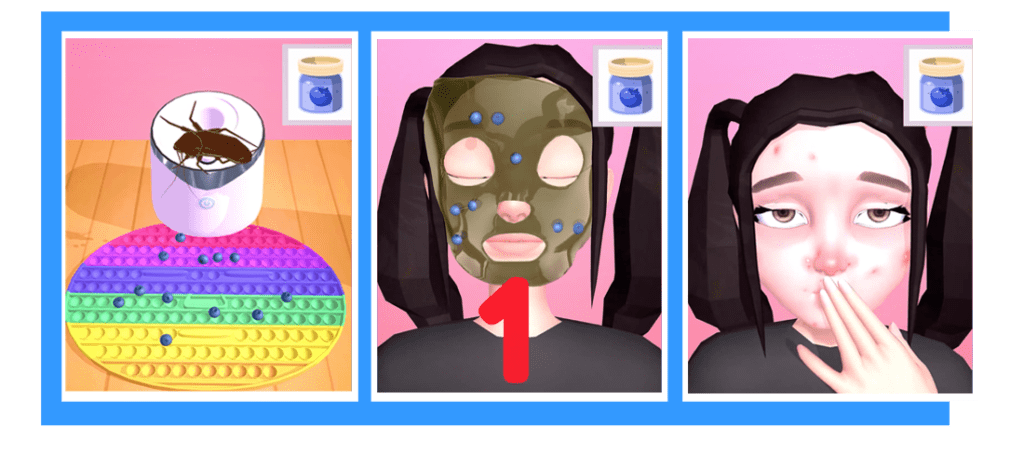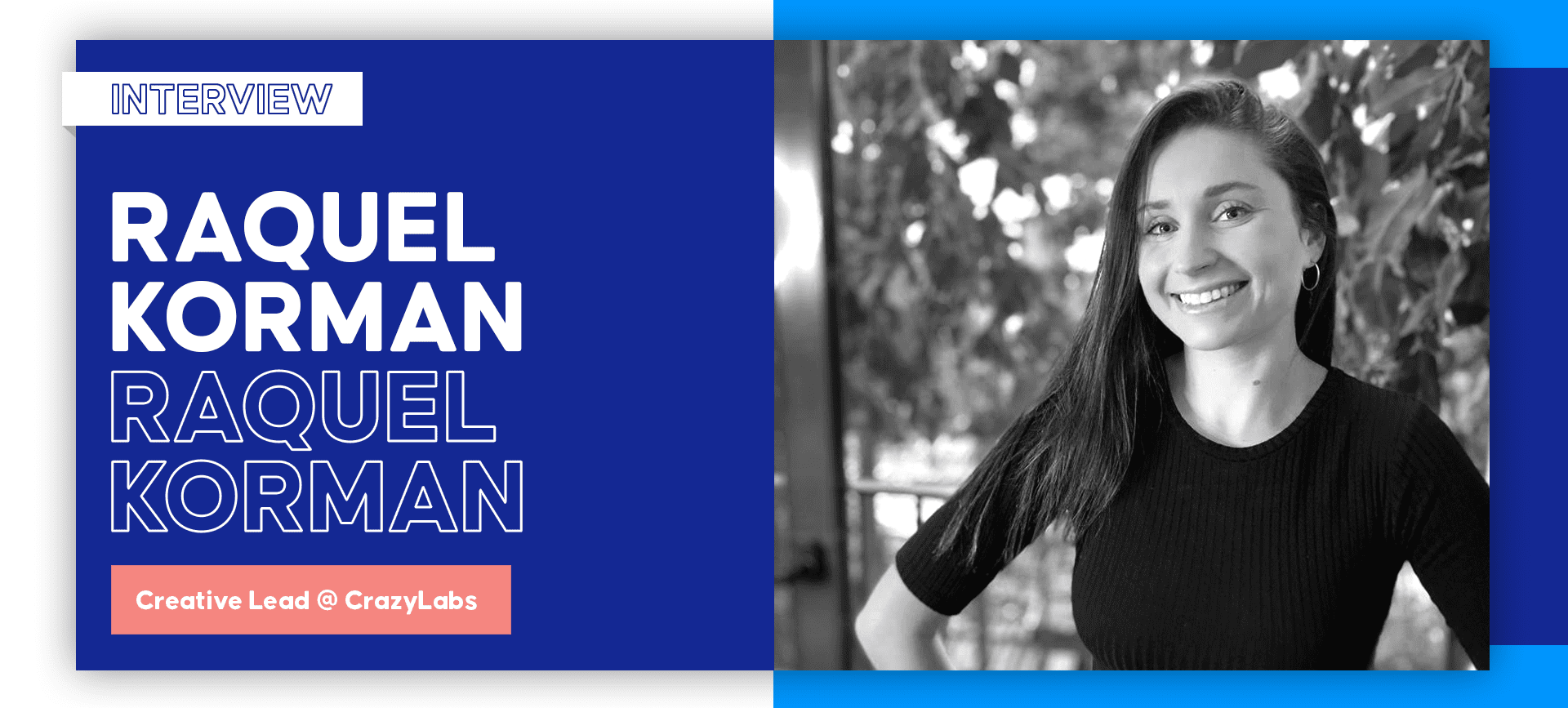For many companies, the key to strong, scalable creative production that both delights users and moves the needle boils down to one thing: producing creatives that strike the right balance between creativity and efficiency.
Curious to learn more? We chatted with CrazyLabs’ Creative Lead, Raquel Korman, on all of the twists and turns of creating better ads, and more. Let’s dive in.
Hi Raquel! What drew you to CrazyLabs initially? And why do you like doing the work that you do?
Raquel: I was initially drawn to CrazyLabs as it’s a top mobile publisher and developer with a strong and diverse hyper-casual gaming portfolio. My background is in film and game design so when I was offered the opportunity to join the CrazyLabs creative marketing team, I knew it was a perfect blend of all my interests.
I love the work that I’m doing because hyper-casual marketing is innately dynamic and constantly evolving, making my day-to-day a lot of fun. I’m always researching what’s hot in marketing, pop culture, social media, and beyond and thinking of creative solutions to incorporate top trends into our creatives.
What are some of the biggest industry changes you’ve seen since you’ve started your role?
Raquel: Since the hyper-casual industry is so dynamic, creative strategies are always changing. A force behind marketing trends in the last year can be accredited to the rise of TikTok as a hyper-casual ally. TikTok is what I call, ‘hyper-content’. Just like hyper-casual games, TikTok videos offer easily snackable content that users can consume whenever without any prior context or storyline.
This media connection has leveled up the hyper-casual marketing game in several ways. Let’s talk about sound – a year ago, users were mostly watching ads on mute. Today, sound is an essential part of TikTok videos, and this familiarity has enabled marketing teams to enhance their overall ad experience by adding interesting narratives to simple gameplay.
Besides sound, TikTok also offers a unique lens into trends that can inspire hyper-casual creatives. This can be a crucial tool for combating ad fatigue as you can always find new ways to freshen up an old creative.
Our content-first world is putting emphasis on the importance of productivity and efficiency into how we produce quality content. How do you frame productivity within this mediated space?
Raquel: Marketing teams need to be efficient but not compromise on the quality of creatives. A good way to go about this challenge is to constantly optimize your winning creative. This video has proven to work, so think about what other stories you can tell with the same gameplay.
Some ideas include adding a voiceover to change the context of the ad, adding a ‘match the photo’ to create a mission, changing the colors, changing the theme, and the list goes on.
We work with various software to help with this process, and Storyteq is a great creative tool that allows us to make quality variations very quickly.
What are the biggest challenges that you see creative production teams facing today? What’s your advice on how to solve these issues?
Raquel: A huge challenge facing creative production teams is how to produce quality at scale. As a hyper-casual publisher, you most likely have a large portfolio as well as new launches that marketing production teams need to give attention to on a weekly or monthly basis.
It’s important to remember that you don’t need to make an ad with Hollywood production value (also we’re talking about hyper-casual, something so polished will likely not work). However, you do want to make a creative that will stick for a long time, so don’t compromise on the end result.
Start with your pure gameplay and think about how to make it as engaging as possible. Make an awesome intro, add UI elements to make things more clear, change the colors, change the sound, add a better wow moment, etc.
Depending on the results of your pure gameplay, the next step may be creating fake gameplay. You can go about this a number of ways, including animation and/or making a special game build. Before you start with fake gameplay, look at what works for your competitors and what’s trendy right now to give you some direction in your creative process. You don’t want anyone to waste days working on something that, in the end, can’t scale.
And again, once you find a winning creative, hold on to it and constantly optimize it for as long as it works.
As a leader in the creative production space, what have you noticed about the production process in that area that you’d like to call out?
Raquel: This past year has been focused on data-driven creation. At CrazyLabs, we work with a creative reporting tool that generates insights and trends.
With data as the creative foundation, everyone involved in the creative production process, including the video editors, first look at the numbers to understand what can make the next winning creative.
In addition, our creative team works very closely with the User Acquisition managers and creative analysts to gather real-time insights across our portfolio.
In your role, you are addressing a global audience; how do you approach the issue of localization in content and reaching out to a diverse audience at scale?
Raquel: For specific geographies, just translation isn’t enough and it’s very important to actually localize the ad’s content. For this, we work with external partners and agencies to ensure our creatives are able to reach the maximum audience around the world.

What piece of advice would you like to give to creative producers struggling to reach their audience in an over-crowded space?
Raquel: Yes, hyper-casual is an over-saturated industry, but there is always room for new titles. If you look at the top charts, there are often many similar themed games. While this may be intimidating, it also shows us that there is always room for new titles in the hyper-casual charts, and it really comes down to execution.
So the easiest answer: make better ads. Of course, this is easier said than done, so here are a few tips to improve your creatives.
First, look at your competitors, who else has a title similar to yours? Are they successful? What creatives worked for them? Which didn’t?
You’ll also need to dive into the skeleton of your creatives. You have most likely heard that you need to have a 3-second hook, keep it simple, follow a linear storyline, give users a reason to watch, and create emotion. This is all very true, but with such an oversaturated industry, these guidelines are requirements, not suggestions if you want your creatives to have a chance to scale.
So the bottom line is, check out what’s working for your competitors to give you some direction. Then once you have your own unique creative, make sure it checks all the right boxes to give you a chance to make it to the top.
Key takeaways from this interview
- Marketing teams need to be efficient but not compromise on the quality of creatives. A good way to go about this challenge is to constantly optimize your winning creative.
- CrazyLabs work with various software to help with this process, and Storyteq is a creative tool that allows them to make quality variations very quickly.
- For specific geographies, just translation isn’t enough and it’s very important to actually localize the ad’s content. For this, Raquel works with external partners and agencies to ensure GameLabs creatives are able to reach the maximum audience around the world.
- Raquel’s advice? “Check out what’s working for your competitors to give you some direction. Then once you have your own unique creative, make sure it checks all the right boxes to give you a chance to make it to the top.”
Enjoyed this conversation? Stay tuned for upcoming interviews with industry leaders and subscribe to our monthly newsletter below.
